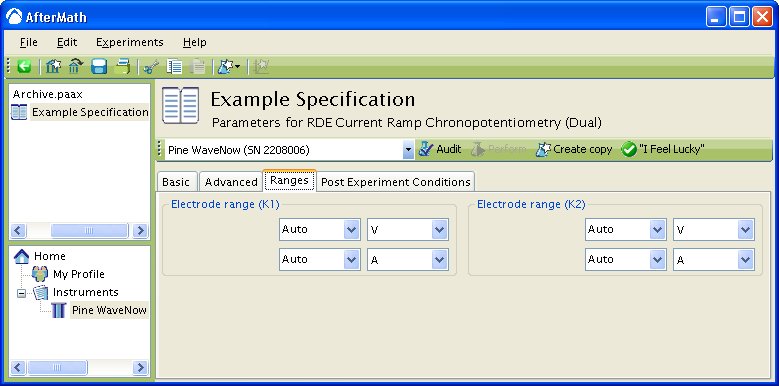
This article is part of the AfterMath Data Organizer Electrochemistry Guide
The choice of measurement sensitivity is very important when performing an electrochemical technique. If the instrument sensitivity is set too low, then small signals may be lost in the noise. If the instrument sensitivity is adjusted too high, then even relatively small signals may overwhelm the measurement circuitry, causing large features in the signal to be “clipped” or truncated.
In almost every electrochemical technique, the software is able to automatically choose the proper sensitivity for the excitation signal. For example, before a cyclic voltammetry experiment even begins, the software is well aware that the potential excitation waveform is a simple triangle wave that will alternate between a few known setpoints. Because the magnitude of these setpoints is known ahead of time, the software can automatically match the proper potential measurement sensitivity to these known setpoint levels. Such “software autoranging” is always possible for whichever signal (potential or current) is the excitation signal.
Choosing the proper range for measuring response signals is a bit trickier. the autoranging feature for response signals, when available, is generally done in “real time” by the instrument itself. During an experiment, the instrument actively monitors the response signal levels and makes “on the fly” adjustments to the range settings. For example, in a cyclic voltammetry experiment, the current generally starts off at some small level. Then, as the potential is swept toward the formal potential for an electroactive substance in the cell, the current begins to increase quickly. The instrument senses this increase in current and automatically switches to a less sensitive current range to prevent the ever-growing current signal from being “clipped”.
The advantage to having an instrument capable of autoranging response signals is that you don't need to specify the signal sensitivity ahead of time. The instrument determines the proper range while the experiment is occurring. The disadvantage of such instrument-based autoranging is that small glitches may be introduced into your results whenever the instrument switches from one measurement range to another. These glitches are caused by a momentary loss of cell control during the circuit switching event.
In the worst case, the proper choice of current or potential measurement sensitivity must be determined by a trial-and-error process. By repeating the same experiment once or twice, you are able to determine the anticipated signal levels and adjust the instrument sensitivity accordingly.
The choice to use autoranging for the potential and current signals is made on the Ranges Tab (see above). By default, both of these range settings are set to “Auto”, meaning that the software and/or instrument will attempt to choose an appropriate signal sensitivity automatically.
Not all instruments support the autoranging feature for response signals. For instruments which do not support this feature, choosing the “Auto” range setting usually causes the least sensitive range setting to be selected.
Links: Electrochemist's Guide, AfterMath User's Guide, AfterMath Main Support Page
Related Topics: specifying ranges





Comments: